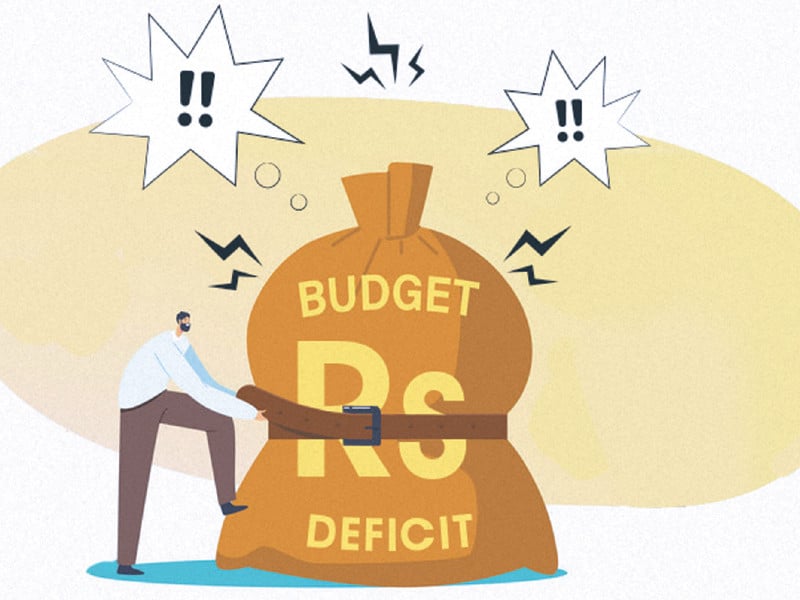ISLAMABAD:
Despite a 53% increase in the government’s net income, the federal budget deficit widened to a record Rs7.7 trillion in the last fiscal year due to uncontrolled debt servicing costs, underscoring the need for a drastic cut in interest rates for any meaningful fiscal consolidation.
The Rs7.7 trillion budget deficit was 16% higher than the preceding year, despite some attempts to control non-interest expenses, according to the fiscal operations summary for 2023-24 released by the Ministry of Finance on Tuesday. The federal government missed its annual deficit target by a margin of Rs220 billion, which was relatively lower than in previous years. In February, the finance ministry had estimated that the federal deficit might reach Rs8.5 trillion.
The details revealed that while the government’s performance in tax and non-tax revenues was encouraging, it failed to curb spending, losing the gains made on the income front. The federal government spent over Rs8.2 trillion on debt servicing—an amount Rs1.06 trillion higher than the net income of Rs7.1 trillion during the last fiscal year. Combined spending on debt and defence totalled Rs10 trillion, which was Rs2.9 trillion higher than the government’s net income.
Another alarming detail was that the finance ministry did not know the source of Rs281 billion in spending, which has been classified as a “statistical discrepancy” in the fiscal operations summary. The federal government’s budget deficit stood at Rs7.73 trillion in fiscal year 2023-24, which ended on June 30, missing the target of Rs7.5 trillion. This was nearly Rs1.1 trillion or 16% higher than the previous year.
In the previous fiscal year, the coalition government and the caretakers added Rs7.7 trillion more to the public debt. The State Bank of Pakistan (SBP) has not yet released the last fiscal year’s debt figures, but it is expected that the gross public debt may exceed Rs71 trillion by the end of June. In terms of the size of the economy, the federal budget deficit equalled 7.3% of the gross domestic product (GDP).
The government’s efforts to contain the deficit have largely focused on increasing revenues with little effort to cut expenditures. It has been incurring expenses in areas that, under the constitution, are not the responsibility of the Centre. For the new fiscal year, the budget is 30% higher.
During the last fiscal year, the federal government’s total expenditures rose to Rs14.8 trillion, exceeding the budget target. This was also higher by Rs3.5 trillion or 31% compared to the previous year. Current expenditures alone amounted to Rs14.1 trillion.
Interest expenses nearly reached Rs8.2 trillion—Rs2.5 trillion or 43% higher than the previous year. For the current fiscal year, the government has budgeted Rs9.8 trillion for debt servicing, which is more than the federal government’s projected net income.
Until the central bank cuts interest rates to close to single digits, the government will not be able to reduce the budget size, despite a phenomenal increase in revenues. The central bank has reduced the interest rate to 19.5% this week, despite significant room for a steep cut.
Everything the government of former Prime Minister Shehbaz Sharif did was through borrowings, including special initiatives, financing the military, paying subsidies, salaries, and covering the costs of running the civilian government. Development spending was Rs732 billion last year, compared to the target of Rs950 billion, to compensate for higher spending on interest payments.
The Federal Board of Revenue (FBR) collected Rs9.31 trillion in taxes, a 30% increase. Non-tax revenues amounted to Rs3.05 trillion, showing a 78% growth, thanks to higher collections of the petroleum levy and profits from the central bank. The collection under the petroleum levy amounted to Rs1.02 trillion—76% higher. The SBP shared Rs972 billion in profits with the federal government, a 162% increase.
As a result, total gross federal revenue receipts amounted to Rs12.4 trillion, Rs3.5 trillion higher than the previous year. The federal government’s total net income, after transferring provincial shares, stood at Rs7.1 trillion, showing a 53% increase.
Despite this 53% increase, the federal government added Rs7.7 trillion to the public debt to finance the deficit. There was a significant increase in domestic borrowings, with the federal government having to take Rs7.4 trillion in new loans from commercial banks and other local sources. Domestic borrowings were Rs2.6 trillion higher than budget estimates.
External creditors provided a net Rs320 billion in new loans to finance the deficit, compared to the anticipated Rs2.7 trillion.





